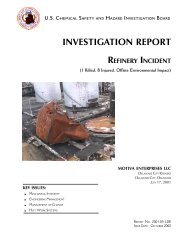CTA Report, Draft 1, ISP Review - US Chemical Safety and Hazard ...
CTA Report, Draft 1, ISP Review - US Chemical Safety and Hazard ...
CTA Report, Draft 1, ISP Review - US Chemical Safety and Hazard ...
You also want an ePaper? Increase the reach of your titles
YUMPU automatically turns print PDFs into web optimized ePapers that Google loves.
B.2 Minimum Explosible Concentration<br />
Minimum explosible concentration (MEC) is the minimum concentration of a combustible dust cloud that<br />
is capable of propagating a deflagration through a uniform mixture of dust <strong>and</strong> air under specified<br />
conditions. MEC data provide a relative measure of the minimum concentration of a dust cloud necessary<br />
for an explosion. The values obtained are specific to the sample (particularly particle size distribution)<br />
<strong>and</strong> test method. MEC values are not to be considered intrinsic material constants. The test was<br />
performed per ASTM E1515-00, St<strong>and</strong>ard Test Method for Minimum Explosible Concentration of<br />
Combustible Dusts (2000b), using the U.S. Bureau of Mines 20-liter explosibility chamber.<br />
Figure B-3 compares MECs for the Borden <strong>Chemical</strong> SD-52SS phenolic resin, Pittsburgh coal dust,<br />
polyethylene dust, <strong>and</strong> cornstarch.<br />
MEC<br />
(g/m³)<br />
70<br />
60<br />
50<br />
40<br />
30<br />
20<br />
10<br />
0<br />
28<br />
50<br />
60<br />
60<br />
Cornstarch<br />
Pittsburgh Pulverized Coal<br />
Dust<br />
SD-52SS + Carbon Black #2<br />
Polyethylene<br />
Figure B-3. Minimum explosive concentration of Durite SD-52SS<br />
compared with other common combustible dusts.<br />
105









